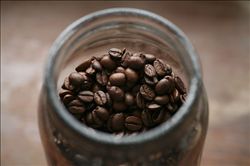Jasmine scented Ethiopian Yega Sheffivoka Coffee growing Environment Fine Coffee is introduced.
Ethiopia is located at 6 ~ 9 degrees north latitude and 34 ~ 40 degrees east longitude. It is located in the center of the Horn of Africa and is a landlocked country. It is bordered by Djibouti and Somalia to the east, Sudan to the northwest, Eritrea to the north and Kenya to the south. [5]
Topography
There are mainly mountain plateaus in Ethiopia, and the central and western regions are the main part of the plateau, accounting for 2% of the total. The East African Rift Valley runs through the whole territory, with an average elevation of nearly 3000 meters, which is known as the "roof of Africa". The terrain around the plateau is gradually declining. The Darol depression in the north fell to 113 meters below sea level, the lowest point in the country. The coast of the Red Sea is a narrow banded plain. Deserts and semi-deserts in the north, south and north-east account for about 25% of the country's area. The Dashan peak of the Ximen Mountains is 4623 meters above sea level, which is the highest peak in Ethiopia. [6]
Climate
Due to the large difference between latitude span and altitude, Ethiopia is located in the tropics, but the temperature is uneven in different places. The heavy rainy season is from June to September, the dry season is from October to January, and the light rainy season is from February to May. Due to uneven rainfall in different seasons and regions, local drought is easy to occur. The temperature ranges from 9.7 ℃ to 25.5 ℃. The average annual temperature is 16 ℃. [5]
Hydrology
There are many rivers and lakes in the territory, where the Blue Nile originates, but the utilization rate is less than 5%. [1]
Natural resources editor
Proven deposits include gold, platinum, nickel, copper, iron, coal, tantalum, silicon, potash, phosphate, marble, limestone, oil and natural gas. Companies from Malaysia, Saudi Arabia, Britain, Sudan, Jordan and other countries have carried out oil and gas exploration and development in Ethiopia. Rich in water resources, known as the "East African water tower". [1]
Population editor
As of 2012, Ethiopia has a population of 91 million, making it the second most populous country in Africa. The population growth rate is 2.9%. [7]
There are more than 80 ethnic groups in the country, mainly Oromo (40%), Amhara (20%), Tiger (8%), Somalia (6%), Sidamo (4%) and so on. 45% of the residents believe in the Ethiopian Orthodox Church, 40-45% believe in Islam, 5% believe in Protestantism, and the rest believe in primitive religions.
By 2012, the three most populous states were Oromo, Amhara and Southern State.
Planting system and environment
The cool and foggy mountain stream village in the Yega-Xuefei producing area is like spring all year round, with a gentle breeze in summer, cool but not hot, rain but not damp, and no cold damage in winter, making it the best environment for planting Arabica. There are no large coffee plantations. Coffee farmers grow coffee mixed with other crops, generally under banana trees, forming a unique landscape. Ethiopia's traditional sun treatment is rough and smelly, which has been criticized. In 1959, the South American water washing method was introduced into the Yega Xuefei producing area. Most producing areas generally adopt the water washing treatment, that is, after the coffee fruit is peeled, the pectin layer is removed after fermentation and washing, and then dried.
Since 2006, some coffee processing plants in some producing areas have adopted the exquisite elevated shed sun drying method, which invests in high-intensity human labor, which isolates the coffee fruit from contact with the ground and prevents the miscellaneous smell of soil in the process of sunlight. create an unusually clean fruit flavor. After more than two weeks of sun exposure, dark brown coffee fruits are professionally stored, waiting for the whole flavor to ripen. Before sale, the dried cherry pulp and sheepskin are removed, and then the unripe beans and over-fermented beans are removed. Strict control greatly improves the quality and flavor characteristics of sun-dried beans.
Washed Yega Chuefei has a unique lemon flavor, refreshing jasmine flavor, as well as soft fruit acid and citrus flavor, fresh and bright taste.
Sun Yega Chuefei has charming fruit acidity, clean fermented fruit sweet, elegant fruit wine, sweet aftertaste.

Important Notice :
前街咖啡 FrontStreet Coffee has moved to new addredd:
FrontStreet Coffee Address: 315,Donghua East Road,GuangZhou
Tel:020 38364473
- Prev

Introduction to the growing environment of Yega Xuefei Adoto coffee with excellent taste
Ethiopia is rectangular, with a ratio of length to width of 3:2. From top to bottom, it is composed of green, yellow and red parallel equal horizontal rectangles, with the national emblem in the middle of the flag. Since the end of the 19th century, Ethiopia began to use the green, yellow and red cross-striped national flag. In modern history, Ethiopia is the first African country to join the forest of free nations. [8] to this century
- Next

Introduction to the planting environment for the flavor and taste of Dominica Santo Domingo coffee
Like Cuba, Puerto Rico, Venezuela and Panama, Dominica is a traditional baseball power. Apart from American players, the largest number of foreign players in major league players is Dominica. These include the most famous Sammy Sosa, Cardinals Albert Pujols, Mets Pedro Martinez, Red Sox David Ortiz (Big Papi), and Dodge.
Related
- Detailed explanation of Jadeite planting Land in Panamanian Jadeite Manor introduction to the grading system of Jadeite competitive bidding, Red bid, Green bid and Rose Summer
- Story of Coffee planting in Brenka region of Costa Rica Stonehenge Manor anaerobic heavy honey treatment of flavor mouth
- What's on the barrel of Blue Mountain Coffee beans?
- Can American coffee also pull flowers? How to use hot American style to pull out a good-looking pattern?
- Can you make a cold extract with coffee beans? What is the right proportion for cold-extracted coffee formula?
- Indonesian PWN Gold Mandrine Coffee Origin Features Flavor How to Chong? Mandolin coffee is American.
- A brief introduction to the flavor characteristics of Brazilian yellow bourbon coffee beans
- What is the effect of different water quality on the flavor of cold-extracted coffee? What kind of water is best for brewing coffee?
- Why do you think of Rose Summer whenever you mention Panamanian coffee?
- Introduction to the characteristics of authentic blue mountain coffee bean producing areas? What is the CIB Coffee Authority in Jamaica?

